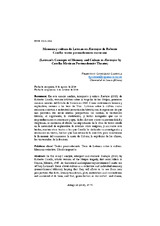Mostrar el registro sencillo del ítem
Memoria y cultura de Lotman en Rastrojos de Roberto Corella: teatro posmodernista mexicano
| dc.contributor.author | González Gaxiola, Francisco | |
| dc.date.accessioned | 2016-11-18T12:56:18Z | |
| dc.date.available | 2016-11-18T12:56:18Z | |
| dc.date.issued | 2014 | |
| dc.identifier.issn | 2386-9658 | |
| dc.identifier.uri | http://hdl.handle.net/10396/14047 | |
| dc.description.abstract | En este ensayo analizo, interpreto y critico Rastrojos (2013) de Roberto Corella, versión artística sobre la tragedia de los Huipas, primeros asesinos seriales del Estado de Sonora en 1949. Como instrumento teórico y explicativo, recurro a las tesis de Yuri Lotman sobre la cultura como memoria colectiva e individual (recordación/olvido) con la esperanza de que nos permitan ver desde nuevas perspectivas los hechos, la traducción literaria, el argumento, la motivación, y tantas incógnitas que no se respondieron en su momento y que, dados factores como su incomodidad y vergüenza, se arrojaron al olvido. La importancia de la obra de teatro reside en la necesidad de explicación de muchos otros enigmas, y así como este hecho, existen otros tantos a los que Corella ha dedicado su investigación y recreación en teatro, hechos que han rebasado la anécdota para caracterizar la fisonomía del sonorense: la santa de Cabora, la expulsión de los chinos, los trasterrados de la frontera. | es_ES |
| dc.description.abstract | In this essay I analyze, interpret and evaluate Rastrojos (2013) by Roberto Corella, artistic version of the Huipas tragedy, first serial killers in Sonora, México, 1949. As theoretical and explanatory instrument I make use of Iury Lotman’s thesis about culture as a collective and individual memory (remembrance/oblivion) hoping that they will allow us to see from new perspectives the facts, literary translation, plot, motivation and conundrums not answered at its time, and that, given factors as disconfort and shame, were thrown into oversight. The importance of Rastrojos drama lays in the necessity of explanation of enigmas to which Corella has dedicated his research and recreation in drama. Besides the Huipas case, there are other outstanding events transtlated into art that exceed the anecdote and which may function to characterize the features of Sonorans: the influence of The Saint from Cabora, the problematic Chinese expulsión from Sonora, and the emigration to the mexican-american border. | es_ES |
| dc.format.mimetype | application/pdf | es_ES |
| dc.language.iso | spa | es_ES |
| dc.publisher | UCOPress | es_ES |
| dc.rights | https://creativecommons.org/licenses/by/3.0/ | es_ES |
| dc.source | Alfinge 26, 57-74 (2014) | es_ES |
| dc.subject | Teatro posmodernista | es_ES |
| dc.subject | Tesis de Lotman sobre la cultura | es_ES |
| dc.subject | Memoria colectiva | es_ES |
| dc.subject | Olvido impuesto | es_ES |
| dc.subject | Postmodernist Theater | es_ES |
| dc.subject | Lotman’s Thesis on Culture | es_ES |
| dc.subject | Collective Memory | es_ES |
| dc.subject | Imposed Oblivion | es_ES |
| dc.title | Memoria y cultura de Lotman en Rastrojos de Roberto Corella: teatro posmodernista mexicano | es_ES |
| dc.title.alternative | Lotman’s Concepts of Memory and Culture in Rastrojos by Corella: Mexican Postmodernist Theatre | es_ES |
| dc.type | info:eu-repo/semantics/article | es_ES |
| dc.relation.publisherversion | https://www.uco.es/ucopress/ojs/index.php/alfinge/index | es_ES |
| dc.rights.accessRights | info:eu-repo/semantics/openAccess | es_ES |

